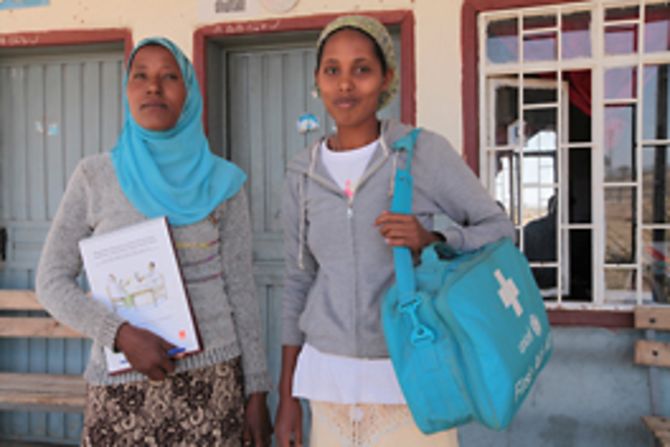Starting point
Two years ago, the number of patients diagnosed with TB in the province of Arssi (region Oromia) was significantly below the expected number. That is good, one might think, but Ato Ahmed Mohammed, representative of DAHW in Ethiopia, had some doubts. He quickly agreed with the government representatives in the national programme against leprosy and TB that many people who are suffering from TB have not yet been recorded in the health system. In Arssi, only 32% of the total estimated number of people suffering from TB were actually diagnosed.
Arssi is one of the poorest regions in Ethiopia, not all inhabitants had access to the health system there, which is very basic to begin with. One reason for this is the very rural structure: 86% of the just under 3 million inhabitants of Arssi live in around 500 villages, very often off passable roads. There are 57 health centres and only two hospitals, one doctor is responsible for almost 30,000 people. Most people have to undertake journeys of two to three days in order to get to a health centre.
Aims of the project
In the region of Arssi, the national TB control programme, which is supported by the DAHW, has set itself the goal of strengthening health care overall and making a timely access to diagnosis and treatment possible for the people living there. This is extremely important in particular in the case of tuberculosis as one person affected can infect scores of people in his surroundings if the disease is not diagnosed and treated. The objective of TB control is to increase the number of TB patients diagnosed within two years from 33% to 60% and to treat the disease according to the standards set by the World Health Organisation (WHO). The active search for TB patients or "active case-finding", which has already proved successful in other countries, is to be used to this end.
Activities
Overall, more than 2,100 employees have been trained – health providers in the villages and better-qualified health workers in the bigger centres, laboratory assistants and supervisors for the entire programme. Overall, 50% of all employees are female. Thus this programme additionally supports the gainful employment of women - in Ethiopia just like in many other developing countries this is not a matter of course.
The health providers undergo additional training taking up to five days, which is financed from funds provided by three relief organisations - the largest share is contributed by USAID, a US organisation; DAHW and the Dutch partner organisation KNCV contributed smaller sums, but made the training possible in the first place by providing suitable qualified personnel. The long-standing experience not only in Ethiopia itself, but also in training and further training of health providers in the fight against TB in many other countries represented a great advantage.
What was achieved in 2010?
Training was completed in the course of 2010 and the employees went right back to work "straight from the classroom": 931 voluntary health providers, another 938 specialised health workers with additional training, 71 laboratory assistants and another 112 employees for general health care as well as 115 supervisors.
There is now a small health post in every village in the region of Arssi. There are always two health providers working at one of the posts, which serve as the field office of bigger and better-equipped health stations. The villages mostly consist of many smaller settlements, for this reason the helpers are often on the road.
Thanks to the smaller health posts, the journey for patients was shortened to one to two hours. Health providers can start with first examinations and - depending on the results and after consultation with the higher level health centres - can plan further treatment steps. At the same time, they use their closeness to the people to raise their awareness of symptoms of TB with suitable information material.
In the last quarter of 2010 already - 18 months after the project had been started – the rate of TB patients diagnosed was raised from 32% to 51% – the goal of 60% is within reach now.
Plans for 2011
The project to train employees was originally planned to last until 30 September 2010, it was, however, extended until 30 June 2011 for the time being. Another extension depends on the funds available - and so does the extension of the project into other regions where similar problems as in Arssi exist.
DAHW estimates costs of 90,000 Euro per year for the running operations in Arssi. The training of health staff in other regions will require 45,000 Euro for each region, this means 450,000 Euro for a total of ten regions.
Risks of the project
The Ethiopian health ministry pays all employees and gets the money to do so from international donors, such as the Global Fund. The poor country would not be able to cope with such costs itself, especially not with the training of the large number of employees. Should these payments be stopped, the entire project would be at risk.
Another risk lies in what is called "Brain Drain": Well-trained medical staff is often wooed away by large companies or international organisations. In this project, employees working in laboratory diagnostics are especially popular.
To avoid this, a higher salary than the Ethiopian state can afford has to be paid to these well-trained employees. DAHW thus often pays this difference to keep good employees. This is much cheaper in the long run than always having to train new employees at this level.



